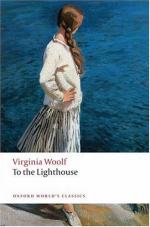|
This section contains 5,345 words (approx. 18 pages at 300 words per page) |

|
SOURCE: “Light in ‘To the Lighthouse,’” in Twentieth Century Literature, Vol. 23, No. 3, October, 1977, pp. 377–89.
In the following essay, Stewart explores the various meanings of darkness and light in the three sections of To the Lighthouse.
The essence of the Lighthouse symbol is Light itself. In “The Window,” Light is the positive force of visionary consciousness; in “Time Passes,” it is the negative counterpart of departed consciousness; and in “The Lighthouse,” it is the reanimation of consciousness in a creative rhythm that seeks spiritual and aesthetic Oneness.
At its first appearance in To the Lighthouse,1 the Lighthouse is a rigid vertical dominating horizontal planes of land and sea. It is seen by Mrs. Ramsay, as part of “the view … that her husband loved” (p. 25): “… the whole bay spread before them and Mrs. Ramsay could not help exclaiming, ‘Oh, how beautiful!’ For the great plateful of blue water was before...
|
This section contains 5,345 words (approx. 18 pages at 300 words per page) |

|


